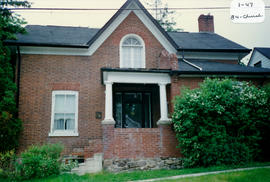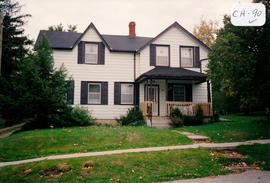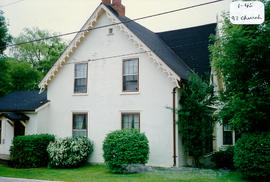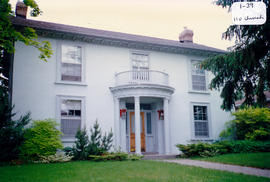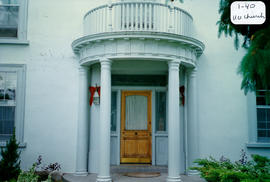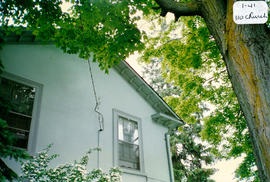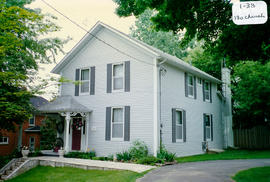84 Church Street - Dr. Ellis House
- CA BWGPL GJ-HB-2017-03-18-01
- Stuk
- 1996
Part of George Jackson fonds
The Dr. Ellis House is located mid-block on the west side at 84 Church Street. It was built pre-1900 in the Gothic Revival Cottage style. Dr. Ellis owned the house in 1900.
The 1½-storey, three-bay structure has a medium-pitched, gable roof and a rectangular plan with a centre hall. The building originally had a symmetrical façade with a centre gable over the front entrance. There are single windows (to the primary rooms) with high floor to ceiling heights on each side of the entrance. The covered, open porch has a flat roof supported on a simple, wood entablature and four ‘half columns’ set onto brick piers on a stone foundation. There is a single door with ¾ height, glass sidelights set above recessed, wood panels and a glass transom at the entrance. The second-storey window above the porch is set halfway into the centre gable in a full, arched opening with brick voussoirs. This window is a full-height casement with a fanlight above the opening onto the roof of the porch and is not original to the house. Double-hung windows at the ground floor are set into segmented, arched openings with brick voussoirs. The 2/2 windows appear to be original. Wood frame construction is clad with brick siding and there is a stone foundation. A single, brick masonry chimney is set in from the exterior north wall. An enclosed, brick-clad extension has been added to the front of the house (adjacent to the porch). Access to the open porch appears to have been changed to the side with new, precast stairs added. According to the 2000 inventory, the front addition has destroyed the original symmetry of the façade and it is not in keeping with the character of the house. (1, 3)
Zonder titel

